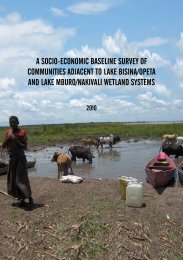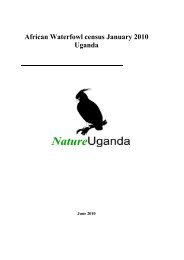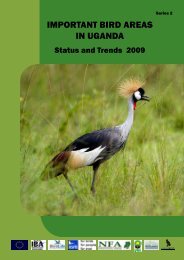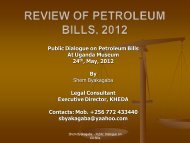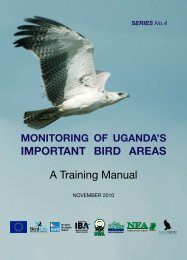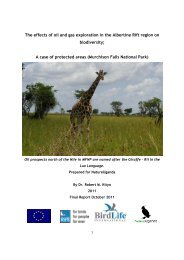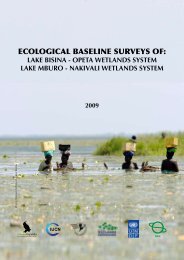the economic valuation of the proposed ... - Nature Uganda
the economic valuation of the proposed ... - Nature Uganda
the economic valuation of the proposed ... - Nature Uganda
You also want an ePaper? Increase the reach of your titles
YUMPU automatically turns print PDFs into web optimized ePapers that Google loves.
part <strong>of</strong> <strong>the</strong> area <strong>proposed</strong> for degazettement in Mabira<br />
may be characterised as a combination <strong>of</strong> open forest<br />
and closed secondary forest. Taking <strong>the</strong> carbon loss<br />
value <strong>of</strong> open forest (52tC/ha) <strong>the</strong> conversion <strong>of</strong> 7186ha<br />
<strong>of</strong> Mabira to permanent agriculture would release<br />
373672tC. Using this value as a benchmark, <strong>the</strong> next<br />
question is what <strong>the</strong> <strong>economic</strong> value <strong>of</strong> such carbon<br />
stock is. A significant literature exists on <strong>the</strong> <strong>economic</strong><br />
value <strong>of</strong> global warming damage and <strong>the</strong> translation <strong>of</strong><br />
<strong>the</strong>se estimates into <strong>the</strong> <strong>economic</strong> value <strong>of</strong> a marginal<br />
tonne <strong>of</strong> carbon (Pearce & Pearce 2001). According to<br />
Zhang (2000) if <strong>the</strong>re were no limitations placed on<br />
worldwide carbon trading, carbon credits would by <strong>the</strong>n<br />
have exchanged at just under $10tC. If ‘hot air’ trading<br />
were excluded, <strong>the</strong> price would be $13tC. Therefore,<br />
taking $10tC as a conservative estimate, <strong>the</strong> one-<strong>of</strong>f<br />
value <strong>of</strong> carbon released into <strong>the</strong> atmosphere would be<br />
$3,736,720 (or Ushs 6,352,424,000).<br />
Secondly, once <strong>the</strong> area is converted into permanent<br />
agriculture, <strong>the</strong>n its annual carbon sequestration<br />
capacity is severely restricted. The removal <strong>of</strong> tree cover<br />
as a result <strong>of</strong> <strong>the</strong> permanent agriculture (plantation) will<br />
result in a loss <strong>of</strong> some <strong>of</strong> <strong>the</strong> carbon storage capacity <strong>of</strong><br />
Mabira CFR. According to Bush et al (2004), at <strong>the</strong> global<br />
level, <strong>the</strong> forestry sub-sector is an important carbon<br />
sink, helping to reduce accumulation <strong>of</strong> greenhouse<br />
gases and hence global warming which will lead to<br />
adverse changes in climate. Emerton & Muramira<br />
(1999) and Bush et al (2004) give <strong>the</strong> following carbon<br />
sequestration values for different <strong>Uganda</strong>n vegetation<br />
types: primary closed forest UShs 54,660/ha/year;<br />
degraded forest UShs 32,538/ha/year; and woodland,<br />
bushland and grassland UShs 2,603/ha/year. The forest<br />
conversion is expected to leave <strong>the</strong> cleared impact area<br />
under grassland (sugarcane) instead <strong>of</strong> bare ground.<br />
Fur<strong>the</strong>rmore, <strong>the</strong> Production Zone should have a carbon<br />
sink value <strong>of</strong> UShs 40,996/ha/year, using <strong>the</strong> average<br />
value for a primary closed forest and a degraded forest<br />
and deducting grassland values.<br />
Multiplying <strong>the</strong> carbon sink value by <strong>the</strong> size <strong>of</strong> <strong>the</strong><br />
applicable impact area, is expected to result in a loss<br />
44<br />
<strong>of</strong> carbon sink values equivalent to UShs 294,597,256/<br />
year. Capitalised at <strong>the</strong> social opportunity cost <strong>of</strong><br />
capital, <strong>the</strong> annual stream gives a present value <strong>of</strong> UShs<br />
2,454,977,133 (or $1,444,104).<br />
G. WATERSHED PROTECTION<br />
Typically, <strong>the</strong> functions forests play in watershed<br />
regulation include: soil conservation (siltation and<br />
sedimentation), water flow regulation (including flood<br />
and storm protection, water supply, water quality<br />
regulation – including nutrient outflow). The effects <strong>of</strong><br />
forest cover removal can be dramatic. Unfortunately,<br />
<strong>economic</strong> studies <strong>of</strong> watershed protection functions are<br />
few, none<strong>the</strong>less progress is being made. From existing<br />
studies Krieger (nd) was able to arrive at average values<br />
<strong>of</strong> tropical forests as follows: water regulation ($6/<br />
ha); water supply/quality ($8/ha); erosion control and<br />
sediment retention $245/ha, resulting in a total <strong>of</strong> $259/<br />
ha. When <strong>the</strong>se average values for all tropical forests <strong>of</strong><br />
<strong>the</strong> world are applied to <strong>the</strong> Mabira case, it translates<br />
into annual watershed protection values <strong>of</strong> $1,760,570<br />
and present value <strong>of</strong> $14,671,417. According to Hamilton<br />
& King (1983), care needs to be taken not to exaggerate<br />
<strong>the</strong>se estimates. Yaron (2001) estimated <strong>the</strong> value <strong>of</strong><br />
flood protection (using <strong>the</strong> value <strong>of</strong> avoidable crop and<br />
tree losses as a basis) and came up with a figure <strong>of</strong> $0-<br />
24/ha. Using Yaron’s upper estimate <strong>of</strong> $24/ha, <strong>the</strong> flood<br />
protection value for <strong>the</strong> Mabira impact area would be<br />
$172,464/year (or UShs 293,188,800 using exchange rate<br />
<strong>of</strong> 1 US$ = UShs 1700) and present value <strong>of</strong> $1,437,200.<br />
While this conservative estimate applies to flood<br />
protection and not <strong>the</strong> o<strong>the</strong>r watershed functions, it<br />
may be used for watershed protection values lost in <strong>the</strong><br />
Mabira impact area.<br />
H. OPTION AND EXISTENCE VALUES<br />
According to Pearce &Pearce (2001), <strong>the</strong> notion <strong>of</strong><br />
<strong>economic</strong> value includes willingness to pay for <strong>the</strong><br />
conservation <strong>of</strong> a forest or ecosystem even though <strong>the</strong><br />
individual expressing <strong>the</strong> willingness to pay secures<br />
no use value from <strong>the</strong> forest. The authors went on to<br />
The Economic Valuation <strong>of</strong> <strong>the</strong> Proposed Degazettement <strong>of</strong> Mabira CFR | 2011



